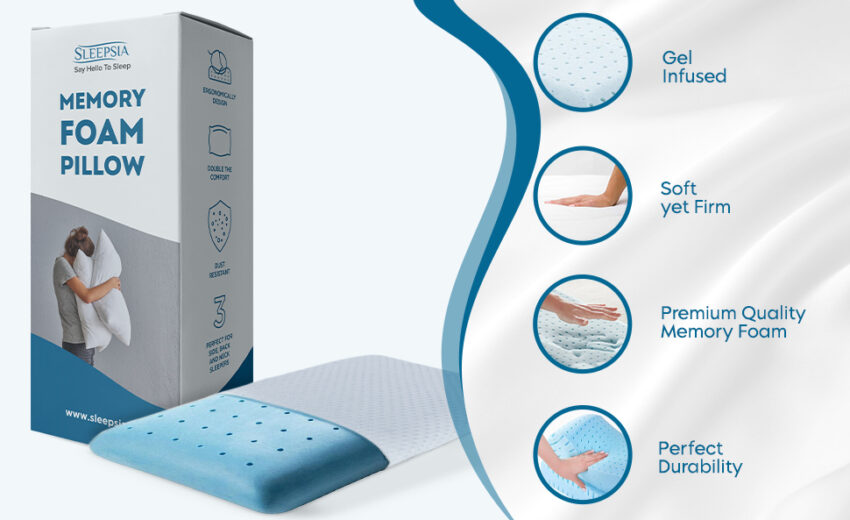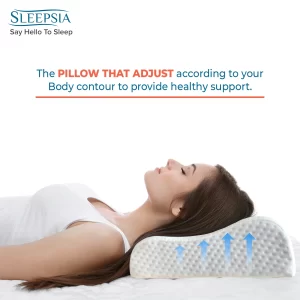
Essential Tips For Sleeping On A Memory Foam Cervical Pillow
It can be hard to get a good night’s sleep when you’re tossing and turning all night because of neck pain or headaches. Read on for helpful tips on how to get the best out of your new Memory Foam Cervical Pillow. Tossing and turning is a common problem for people with neck pain. All those spinal discs and vertebrae can be pretty sore after an accident or surgery, and for some people, that can translate into neck pain.
The best way to sleep when you have neck pain is to get the right kind of mattress—whether it’s a bed, sofa or even a memory foam mattress. Your body needs support, so if you’re sleeping on a hard surface that doesn’t give you that support, you’re going to wake up with a stiff neck. Memory foam is the perfect solution, offering great support while still allowing you to sink in some as needed. Memory foam is great at collecting and retaining body heat, and it’s soft, yet supportive. It’s also fantastic for tossing and turning in the middle of the night without waking up because it gives your body exactly what it needs. And no one wants to wake up in pain every morning!
What are the benefits of a Memory Foam Cervical Pillow?
Memory foam pillows are great for anyone who sleeps on their side. Memory foam is lightweight and conforms to the shape of your head, neck, and shoulders easily. There are many features that make it a good pillow for a side sleeper. It keeps your body in proper alignment, reducing back pain and neck problems while sleeping. Memory foam also softens when you press on it, making it comfortable to sleep on your stomach as well.
A memory foam material is made from millions of tiny air pockets, each filled with a viscoelastic (Visco) fluid . These tiny beads are glued or pressed together to form a layer in the pillow. When you lay on the pillow, your body weight compresses this material which causes the viscoelastic fluid to flow between the air spaces and change its shape. This gives you a new feel every time you sleep on it. Visco elastic fluids also have the ability to absorb and slowly redistribute their shape as well as provide a cooling effect.
Memory Foam Cervical Pillows for Side Sleepers
 Memory foam cervical pillows for side sleepers are an excellent choice. Side sleepers need a contoured, solid support that is not squishy and that will help prevent discomfort during the night. One of the most common complaints among side sleepers is that their necks feel sore or strained after sleeping on a traditional pillow. Memory foam cervical pillows provide a firm and comfortable cushion while maintaining spinal alignment. An additional advantage is that they don’t flatten out over time like the traditional cervical pillows, so they can last for years.
Memory foam cervical pillows for side sleepers are an excellent choice. Side sleepers need a contoured, solid support that is not squishy and that will help prevent discomfort during the night. One of the most common complaints among side sleepers is that their necks feel sore or strained after sleeping on a traditional pillow. Memory foam cervical pillows provide a firm and comfortable cushion while maintaining spinal alignment. An additional advantage is that they don’t flatten out over time like the traditional cervical pillows, so they can last for years.
Many side sleepers find it very uncomfortable to sleep on their backs because their necks tend to wrinkle and push up against the pillow. At this point, you may want to look into investing in a memory foam neck pillow. Memory foam pillows are made of high quality materials which stretch and conform to the shape of your neck while providing support and comfort.
Memory Foam Cervical Pillows for Back Sleepers
 Memory foam cervical pillows are a popular item that last night sleepers have started to use. They are made with memory foam and can provide comfort and relief from pain in many different ways. These pillows support the curves of your neck and head while offering a good amount of pressure. Memory foam is also very durable, so it won’t break down or get uncomfortable over time like other types of materials can do. Cervical pillows are a good choice if you have any types of neck or back problems. It’s important to find the right size pillow that fits well with your head and neck. Otherwise, it won’t provide the right amount of support and may even give you pain instead of comfort. Cervical pillows can help reduce headaches, stiff necks, muscle pain and more.
Memory foam cervical pillows are a popular item that last night sleepers have started to use. They are made with memory foam and can provide comfort and relief from pain in many different ways. These pillows support the curves of your neck and head while offering a good amount of pressure. Memory foam is also very durable, so it won’t break down or get uncomfortable over time like other types of materials can do. Cervical pillows are a good choice if you have any types of neck or back problems. It’s important to find the right size pillow that fits well with your head and neck. Otherwise, it won’t provide the right amount of support and may even give you pain instead of comfort. Cervical pillows can help reduce headaches, stiff necks, muscle pain and more.
Memory Foam Cervical Pillows for Sleeping on your back
Memory foam is a type of material that has a layer of conforming, open-celled, resilient polyurethane. It is used in mattresses and pillows because it provides an unmatched level of comfort and support without the pressure points found in other types of materials. Memory foam comes in many different shapes and sizes, with varying levels of viscoelasticity to match your preferences. We carry several different shapes of memory foam pillows, including:
“The absolute best part about this bed is that it’s incredibly light-weight. My old spring mattress and box spring (which was pushing the limits of what I could physically lift) were a nightmare to move from the second floor to the first, but this bed is a joy to move at all. Put it on the floor and just push/pull them around until everything’s where you want it.”
Don’t forget about comfort
Not all pillows are created equal, and this is especially true when it comes to bedding. A memory foam cervical pillow is designed to be soft and provide a comfortable sleep. It also has the added benefit of being able to contour to your head and neck, providing support that allows you to avoid any neck pain during the night. Memory foam pillows can also retain their shape better than other types of pillows.

If you want to sleep on your stomach, then a contour pillow may be the best choice for you. The shape of the pillow, which is contoured to your head and neck, allows it to conform nicely to your head, eliminating pressure points and helping you stay comfortable throughout the night. If you’re already sick of tossing and turning in bed all night long, then this type of pillow could eliminate that problem as well.
Conclusion
While there is no definitive answer on which type of pillow is better, the best thing to do is try a variety of pillows to find what’s best for your neck and personal preference.


